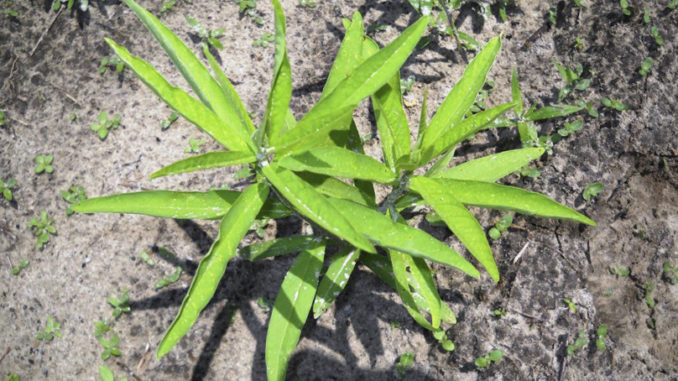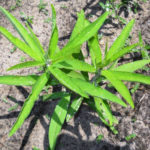
Over the past few years, a lesser-known agriculture seed choice has appeared as a better option for reviving poor sites for farmers across the Deep South. Hunters looking for a more successful option for increasing soil fertility and creating a high-protein fuel source should consider planting sunn hemp this spring in food plots.
Sunn hemp is a warm-season legume native to tropical/subtropical India that matures 60 to 90 days from planting. It is a fast-growing crop — an inch of growth per day up typically up to 5 to 6 feet.
Deer and other wildlife can utilize stands of sunn hemp as cover and as a high-protein forage component. The leaves of sunn hemp grow to 3 to 4 inches long and contain from 25- to 30-percent crude protein that can fuel the herd during periods of fawn rearing and antler growth.
While most extremely sandy sites are avoided for food plots, sunn hemp can flourish on poor sites, even in acidic soils. While neutral sites with a pH of 7.0 are capable of producing optimum results, sunn hemp is known to produce sites as low as 5.0.
Overall, most farmers and food-plot growers have heard very little about this crop. Sunn hemp has been utilized in commercial agriculture around the world for more than 100 years. According to the U.S. Department of Agriculture, sunn hemp is regularly planted in Bangladesh and Brazil to improve soil productivity on a large scale across their agriculture.
Available research dating to the 1930s illustrates that sunn hemp improves soil fertility by increasing available potash, organic matter and phosphorus in the topsoil. Since sunn hemp is a legume, nitrogen reserves can build to 100 pounds or more per acre as well. Well-drained, sandy sites are often troublesome for most food-plot growers, and sunn hemp may be the perfect solution.
While soil productivity can be adjusted with granular applications on most sites, well-drained, sandy sites routinely have issues accepting granular and pulverized nutrient applications due to severe leaching and other factors. Food-plot growers can maintain sunn hemp on these sites into the early fall or disk up and plant a cool-season option with much better results than ever because of the potash, phosphorus and organic matter.
Since sunn hemp is native to warm climates, planting in the Carolinas should take place in May, when soil temperatures are well above 70 degrees. Typically, warm-season plantings are susceptible to weed competition and must be controlled with pre-plant, soil-active herbicides, but sunn hemp will out-compete all native plants when planted on a clean soil bed. On the other hand, if a no-till drill is used, the site should be burned down with glyphosate two weeks before drilling.
For best results, a site should be plowed and seeds planted on a firm seed bed to promote good seed-to-soil contact by either drilling, using a planter or broadcast. While using a seed planter or drill, bury seeds ½ -inch deep at a rate of 15 to 20 pounds per acre. Broadcast seed should be distributed at 30 to 40 pounds per acre, but seeds should be worked into the soil with a chain harrow followed up with a seed roller or cultipacker for best seed-to-soil contact.
For the first planting, 150 to 250 pounds per acre of a general-purpose fertilizer high in potash, phosphorus and sulfur should be applied at planting to jump-start the crop. Planting sunn hemp with other food-plot seeds is not recommended. Sunn hemp will out-compete and eventually shade out anything else trying to grow.
As soon as growth begins, deer and other wildlife will be able to forage on the buds and leaves. The aggressive growth rate will prevent the potential for over-browsing. However, as soon as the plants begin to reach 3 to 4 feet tall, the stalks become fibrous and tough. Even though the leaves will remain tasty, food-plot growers can encourage tender growth by mowing the stand down to 12 inches. Deer will feast on the tender buds, sprouts and new leaves as they rebound from mowing.
Sunn hemp is a good option for warm-season food plots because it improves soil productivity and provides a high-protein food source, as well as cover. However, sometimes when planting a new food-plot crop, deer will sometimes fail to get with the program and leave thousands of pounds of groceries in the field. Quite often, it takes a while for deer to realize that an available plant is good to eat or not. But even if the deer fail to eat a single leaf, the improvements in soil productivity will be well worth the cost and planting effort. Plots that were considered dead, sandy sites can be planted with a fall crop to bring them back into production and get a trophy buck into range this season.
While sunn hemp is not as readily available as many other food-plot seeds, local agriculture seed suppliers should be able to provide sunn hemp for spring plantings. In addition, multiple companies online, such as Hancock Seed and Amazon, can ship sunn hemp to land managers in the Carolinas.






Be the first to comment